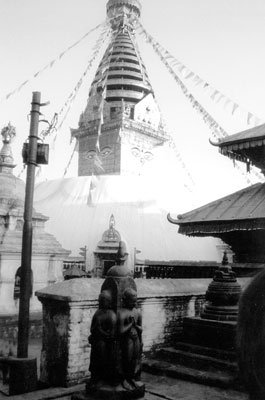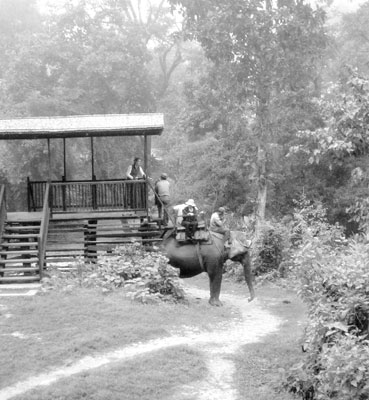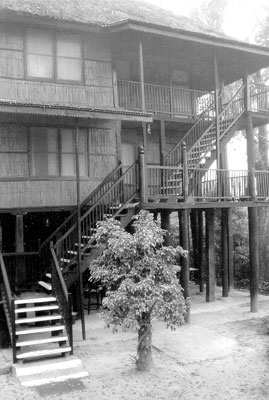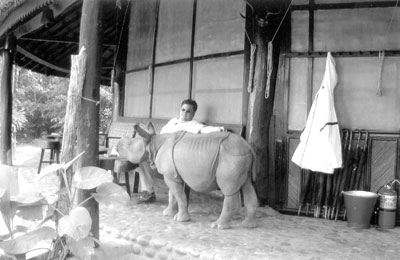Connecting with the animals at Nepal’s Tiger Tops Jungle Lodge
by Jack Ogg, Houstin, TX
My wife, Connie, and I, in planning our Southeast Asia trip with our son Jon and his wife, Kendra, in late 2003, originally intended to include only Hong Kong, Singapore, Thailand and Cambodia (the countries included in our special Cathay Pacific promotion) on our itinerary. However, the more we read, the more we wanted to extend the trip to Nepal. The very names Kathmandu, Mt. Everest and Tiger Tops conjured up our spirit of adventure. We were not disappointed.
Kathmandu
We flew Thai Airways to Kathmandu. The weather was idyllic and the view of Mt. Everest and the Himalayan range was superb. Clearing Customs and getting our visas processed was, however, an adventure of its own. We arrived the day after the U.S. government had frozen the American bank accounts of the Nepalese Maoist guerillas (no connection to China) — and at the height of the climbing/trekking season. We presented our extra photos and $35 fees, smiled very nicely at the police and soldiers guarding the airport and finally made our way through Customs.
We quartered at Dwarika’s Hotel, less than five minutes from the airport yet forming a virtual oasis in the city. We were met by the owner, Mrs. Ambica Shrestha, a charming and gracious widow who has run the compound since her husband’s untimely death.
After making certain our spacious rooms were acceptable and confirming our reservations for our special 6-course Nepalese dinner that night at Krishnarpan (one of three restaurants at Dwarika’s), our hostess departed. We freshened up, cleared the dust from our throats, had a wonderful lunch and set out to tour the city.
The Nepal portion of our trip was arranged by Steve Webster of Escape 2 Nepal Travel. The transportation, accommodations, guides and air and land connections were perfect.
Our guide took us to numerous palaces and Hindu temples and to Swayambhunath Stupa, better known as the “monkey temple.” It sits high above the city and offers marvelous vistas. Although the temple is very religious in nature, its nickname is easy to fathom. Monkeys are literally everywhere, stealing food from one another and from unsuspecting children.
A real highlight of our city tour was Patan, a suburb of Kathmandu. Visiting its ancient monasteries, stupas and palaces was like walking through centuries past. The bazaar in Durbar Square teems with street vendors, shopkeepers, buyers and those just “hanging out.” Unusual items and gifts were plentiful at bargain prices. Our ladies loved it.
After our return to the hotel and a refreshing swim, we dressed for our great Nepalese meal. We were seated on mats at low tables. The dinner ($20 per person) featured wild peppers with potato powder, minced meat dumplings, long-stemmed Himalayan rice, chicken curry, eggplant and other assorted vegetables, with rice wine poured from above by ladies dressed exotically in traditional native costume.
Off to Tiger Tops
After a splendid breakfast the next morning, we were off to Tiger Tops Jungle Lodge via a 30-minute flight on Yeti Airlines. Tiger Tops, located in Royal Chitwan National Park in southern Nepal, is situated on the Reu River, a tributary of the Ganges, and is only five or six jungle miles from the Indian border. It is closed during the monsoon season (June through September).
Tiger Tops was founded by an American group in 1965 and is now owned by a British company. It was recently refurbished and consists of two main 3-story “treehouse” bungalows of 20 rooms each plus extra quarters, an office complex, a kitchen and elephant stables built around the Gol Ghar (Round House), which contains the bar, dining and common gathering area. The meals are served family style, the bar is well stocked and the service is excellent.
Lectures, instructive seminars and slide shows all occur there. We found them very informative regarding the local environment and its flora and fauna.
The entire complex is solar powered, and the only telephone and computer are in the office. Although started as a hunting lodge, Tiger Tops is now so conservation-conscious that most of its food is produced on its two organic farms. The water comes from an underground aquifer, and all fruits, vegetables and salads are washed in boiled, filtered water and sterilized in potassium permanganate. What can be recycled, is.
There are actually three other lodges and tent camps owned by the Tiger Mountain Group, but Tiger Tops is their premier lodge. It provides a first-class wildlife experience, safely, in a remote jungle atmosphere.
Getting from the airport is a part of the adventure. You are jeeped past fields and villages of the native Tharu people and cross two rivers, one of them by boat. We envisioned a ferry or at least a barge that poled across. We were met instead by a skiff that was just large enough for us, our baggage and two hitchhikers. Although sitting low in the water, we did make it across and sighed in relief.
On safari
After arrival and an introductory briefing, we took an afternoon elephant safari looking for Royal Bengal tigers. The safaris were the highlight of the visit. Connie’s letter to a girlfriend perfectly describes our first safari at Tiger Tops:
…our first elephant safari was really special.
We went to the two-story elephant platform, climbed it and mounted our elephant on the howdah (elephant saddle). The barefooted driver sits just behind the head, then comes the saddle where we sit back to back, and a barefoot naturalist stands on the last vertebra of the elephant, holding on to the saddle.
The driver primarily commands the elephant with his feet, although he continually speaks to it in Hindi since the elephants mostly come from India. The driver carries a long bamboo stick that is occasionally used to “whack” the pachyderm when communication fails. We sat 12-15 feet above the ground riding on Samshere Gaj (meaning “royal male”), the only male elephant at Tiger Tops...
So off we rode into the pristine forests, tangled jungle and grasslands with 20- to 25-foot-high grass, in search of Tiger. We saw lots of tiger tracks and several Great One-Horned Rhino with their folds of skin that make them appear as ancient armor-plated warriors. We also spotted two or three species of deer, oxen, golden jackals, monkeys and the very rare Gharial (needle-snouted) Crocodile… Since the tiger is primarily a nocturnal animal, we didn’t spot any.
But, oh, the excitement of coming face-to-face with huge rhino. Jon and Kendra’s elephant surprised a rhino in tall grass. Both animals went separate directions. Jon and Kendra probably said a couple of “Our Fathers.”
There were many other animals and birds that we spotted on our morning and evening safaris, such as egrets, darters, storks, ibis, kites, teal, peacocks, quail, the beautiful red-wattled lapwing and the greenshank.
Each safari lasted about two hours and was within a 3- to 4-mile radius of the lodge. We also took a river safari down the swift Rapti River, which, like all Nepalese rivers, originates in the Himalayas.
Touching moments
Another touching event at the lodge was meeting Mongol, a baby rhino who was orphaned when his mother got washed downstream in the monsoon. One of the staffers found him and became his caretaker and surrogate parent.
Mongol will follow you around like a little puppy. One morning Jon and I were on the Gol Ghar porch having coffee, and Mongol came up and put his head in Jon’s lap.
The morning we left, Connie came up missing as we were loading out, and we looked immediately at the elephant stables. Sure enough, there was my animal-loving wife feeding Chan Chan Kali, a 35-year-old female elephant whom she had fed, petted, loved and bonded with the previous day. Between eating her elephant sandwiches — foot-long bundles of banana leaves wrapped around rice laced with molasses — Chan Chan was lifting her trunk for Connie to scratch. As Connie left, I would almost swear they both had tears in their eyes.
We bade good-bye to the staff, including our naturalist and constant companion, Kalu Ram Tamang, who entertained us with animal and bird imitations all the way back to the airport. The entire Tiger Tops staff made our stay memorable.
After our return to Dwarika’s in Kathmandu, we had our last highlight of the trip: flying Buddha Air around Mt. Everest. The sky was blue and cloudless and everyone had window seats for viewing and picture taking.
We all marveled at the pristine scenery as we flew up and back along the spine of the Himalayas at 30,000 feet. As Buddha Air’s slogan says, we didn’t climb Mt. Everest, but we touched it with our hearts.
Accommodations
The regular rate per room at Dwarika’s Hotel is $195 plus tax, and Tiger Tops runs about $300 per person per day. However, Steve at Escape 2 Nepal Travel (P.O. Box 8975, EPC 4051, Kathmandu, Nepal; phone +9771 4377998 or visit www.escape2nepal.com) arranged our stay for about 60% of the regular rate.
Our trip was excellently planned and fairly priced.





